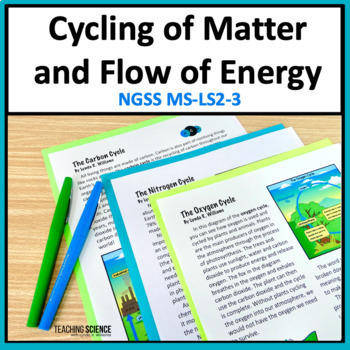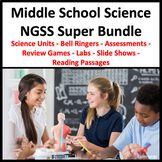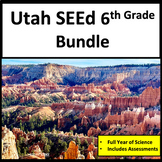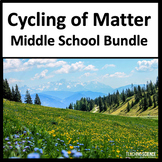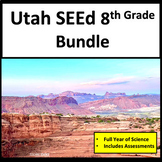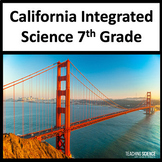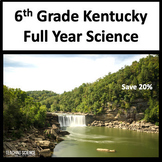Nitrogen Cycle, Carbon Cycle, and Oxygen Cycle - Cycling of Matter MS LS2-3
- PDF
What educators are saying
Also included in
- Do you teach 6th-grade science in Indiana? This is a full-year bundle for the Indiana Science Standards for 6th grade. This bundle covers all the 6th-grade standards and gives your science activities for the year! Aligns with 2023 Indiana Academic Science Standards. Benefits of this Bundle:phenomenaPrice $104.76Original Price $130.95Save $26.19
- This bundle is for Indiana Science Standards 7th Grade. It covers all the standards for 7th-grade science in Indiana. This is a full-year bundle for the Indiana Science Standards for 7th grade. This bundle covers all the 7th-grade standards and gives your science activities for the year! Aligns withPrice $133.60Original Price $167.20Save $33.60
- This NGSS Middle School Science Bundle is my biggest bundle! It includes all my middle school science units, Bell Ringers, Jeopardy-style games, Assessments, and Informational Text Science Units for Middle School. It addresses all the NGSS standards for 6th, 7th, and 8th Grade NGSS science. Save whePrice $489.55Original Price $699.35Save $209.80
- This HUGE Bundle addresses the NGSS MS LS Interactions, Energy, and Dynamics. Students will learn about interactions between organisms, cycling of matter and flow of energy, physical and biological components of an ecosystem, and designing a solution to address an ecological problem.This Bundle ContPrice $37.99Original Price $53.74Save $15.75
- This Bundle for Utah SEEd 6th grade includes science resources for each strand and standard. Each unit included addresses a Utah SEEd standard for 6th grade. Students will love these engaging activities for Utah SEEd 6th Grade. You will love saving time by having someone creating resources who reallPrice $117.56Original Price $146.95Save $29.39
- This bundle meets Matter and Energy in Organisms and Ecosystems for middle school science. How do matter and energy move through organisms in ecosystems? How are energy and matter moved from the Sun to plants to organisms that eat the plants? This complete bundle for Middle school addresses all thePrice $33.40Original Price $47.75Save $14.35
- This Bundle for Utah SEEd 8th grade includes science resources for each strand and standard. Each unit included addresses specific Utah SEEd standards for 8th grade science. Students will love these engaging activities for Utah SEEd 8th Grade. You will love saving time by having someone create resouPrice $122.04Original Price $152.55Save $30.51
- Do you want to save time in planning for middle school science? This Middle School Science Curriculum Bundle addresses all the DCIs for Middle School NGSS. Complete units with phenomena-based 5E Science Lessons for 6th, 7th, and 8th Grade.Save more than 30% by purchasing this bundle! ❤️ Get back toPrice $304.32Original Price $434.75Save $130.43
- This is a bundle for 7th Grade: NGSS Integrated Model. This bundle covers the PEs and standards for NGSS for 7th grade in the California Preferred Integrated Model. Purchase of this bundle will save you 20% on these science resources. If you teach 7th grade in California, you need this bundle.This IPrice $111.80Original Price $143.00Save $31.20
- Do you teach life science in middle school? Perfect for 6th, 7th, and 8th Grade life science. Purchase this life science bundle and save 20%. This bundle covers all the life science standards for middle school NGSS. LS1: From Molecules to Organisms: Structures and Processes, LS2: Interactions, EnerPrice $122.88Original Price $153.60Save $30.72
- Do you teach 7th-grade science in South Carolina? This bundle is a year-long set for 7th-grade South Carolina based on the South Carolina College and Career Readiness standards. My resources include phenomena, Science and Engineering Practices, and Crosscutting Concepts. Students will love the variePrice $108.40Original Price $135.50Save $27.10
- Do you teach 6th-grade science in Kentucky? You need this science bundle! This Kentucky 6th-grade curriculum covers all the standards for Kentucky sixth-grade science. It is a full year of science lessons, and you save 20% on these resources by purchasing them in the bundle! Over 800 pages and sliPrice $107.20Original Price $134.90Save $27.70
Learning Objective
Students will learn about the nitrogen cycle, the carbon cycle and the oxygen cycle that move energy and matter among living and nonliving parts of the ecosystem.
Description
Do your students need to learn about the nitrogen cycle, carbon cycle, and oxygen cycle? Students will make a model to show the cycling of matter. Students will learn that matter is cycled through our Earth's systems. This resource provides great background information and reading passages on the nitrogen, carbon, and oxygen cycles. This resource addresses both MS NGSS and a similar Utah SEEd standard. ✍
Why do you need this resource?
- No-prep, ready to use
- Background information on the cycling of material (carbon, nitrogen, oxygen)
- Visual aids and diagrams
This unit includes:
- Nitrogen Cycle Reading Passage
- Carbon Cycle Reading Passages
- Oxygen Cycle Reading Passages
- Comprehension questions
- Interactive notebook inserts
- A quiz in the format of end-of-year testing
♳♳♳♳♳♳♳♳♳♳♳♳♳♳♳♳♳♳♳♳♳♳♳♳♳♳♳♳♳♳♳♳♳♳♳♳♳♳♳♳♳
Standards Addressed:
✅ NGSS LS2-3 Develop a model to describe the cycling of matter and flow of energy among living and nonliving parts of an ecosystem.
✅ Utah SEEd 6.4.3
Develop a model to describe the cycling of matter and flow of energy among living and nonliving parts of an ecosystem.
Teachers Love This Resource! ❤️
Amy ⭐️ ⭐️ ⭐️ ⭐️ ⭐️
"This resource is wonderful! I love that it is cross-curricular in nature. It allows the practice of reading skills and develops content-specific knowledge. I found the passages to be informative, without going beyond my student's level of understanding."
* My resources are secure and not editable for copyright reasons.
Save 20% by Purchasing in the Bundle Utah SEEd 6th Grade Year Long
Save 20% by purchasing in this bundle Matter and Energy in Organisms and Ecosystems LS1 Strand Bundle
Lynda R. Williams creates these resources at Teaching Science
Follow me and get news of my new resources. Each new resource is discounted by 50% for the first 24 hours!
Created by Lynda R. Williams
Teaching Science With Lynda
Please see my other resources for NGSS MS and for Utah SEEd
Patterns of Interactions of Organisms MS NGSS LS2-1 and MS NGSS LS2-2
Patterns of Interactions in the Ecosystem Utah SEEd 6.4.1 and 6.4.2
Owl Pellet Unit For 6th Grade NGSS MS LS 2.3 and NGSS MS LS 2.4

